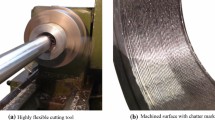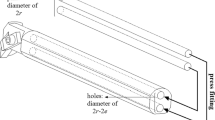Abstract
Due to the factors of limited rigidity and small inherent damping of boring bars, very small depths of cutting can be applied for chatter free machining. Stability lobe diagrams can truly represent that limit. Boring operations are categorized based on the relative motion between the boring bar and workpiece. Modelling of each category is presented in detail using a 3-DOF model. The dynamics of such systems can be successfully represented using ordinary delay differential equations and time periodic delay differential equations. The open loop stability of each type of boring operation is numerically investigated. It has been observed that the stable depth of cut is much more for revolving bar (RB) as compared to stationary bar (SB) boring process. Active chatter control (ACC) techniques can enhance the material removal rates and surface finish of the workpiece. The feasibility of active chatter control for each category is investigated in detail. It is further observed that RB boring process is not a suitable candidate for ACC because much higher harmonic control forces are required for minor improvement in critical depth of cut.

















Similar content being viewed by others
References
Klein RG, Nachtigal CL (1975) A theoretical basis for the active control of a boring Bar operation. J Dyn Syst Meas Control 97(2):172–178. https://doi.org/10.1115/1.3426898
Rao BC, Shin YC (1999) A comprehensive dynamic cutting force model for chatter prediction in turning. Int J Mach Tools Manuf 39(10):1631–1654. https://doi.org/10.1016/S0890-6955(99)00007-3
Eynian M, Altintas Y (2009) Chatter stability of general turning operations with process damping. J Manuf Sci Eng 131(4):041005–041010. https://doi.org/10.1115/1.3159047
Tanaka H, Obata F, Matsubara T, Mizumoto H (1994) Active chatter suppression of slender boring Bar using piezoelectric actuators. JSME Int J Ser C Dyn Control Robot Des Manuf 37(3):601–606. https://doi.org/10.1299/jsmec1993.37.601
Redmond MJ, Barney P (1997) Development of an active boring bar for increased chatter immunity:3044. https://doi.org/10.2172/563816
Wang M, Fei R (2001) On-line chatter detection and control in boring based on an electrorheological fluid. Mechatronics 11(7):779–792. https://doi.org/10.1016/S0957-4158(00)00044-1
Pratt J, Nayfeh A (2001) Chatter control and stability analysis of a cantilever boring bar under regenerative cutting conditions:359. https://doi.org/10.1098/rsta.2000.0754
Andrén L, Häkansson L, Claesson I (2003) Active control of machine tool vibrations in external turning operations. Proc Inst Mech Eng B J Eng Manuf 217(6):869–872. https://doi.org/10.1243/09544050360673251
Chen F, Lu X, Altintas Y (2014) A novel magnetic actuator design for active damping of machining tools. Int J Mach Tools Manuf 85:58–69. https://doi.org/10.1016/j.ijmachtools.2014.05.004
Mei D, Kong T, Shih AJ, Chen Z (2009) Magnetorheological fluid-controlled boring bar for chatter suppression. J Mater Process Technol 209(4):1861–1870. https://doi.org/10.1016/j.jmatprotec.2008.04.037
Ganguli A, Deraemaeker A, Preumont A (2007) Regenerative chatter reduction by active damping control. J Sound Vib 300(3):847–862. https://doi.org/10.1016/j.jsv.2006.09.005
Ganguli A, Deraemaeker A, Horodinca M, Preumont A (2005) Active damping of chatter in machine tools - demonstration with a ‘hardware-in-the-loop’ simulator. Proc Inst Mech Eng I J Syst Control Eng 219(5):359–369. https://doi.org/10.1243/095965105X33455
Tewani SG, Rouch KE, Walcott BL (1995) A study of cutting process stability of a boring bar with active dynamic absorber. Int J Mach Tools Manuf 35(1):91–108. https://doi.org/10.1016/0890-6955(95)80009-3
Shiraishi M, Yamanaka K, Fujita H (1991) Optimal control of chatter in turning. Int J Mach Tools Manuf 31(1):31–43. https://doi.org/10.1016/0890-6955(91)90049-9
Mei C, Cherng JG, Wang Y (2005) Active control of regenerative chatter during metal cutting process. J Manuf Sci Eng 128(1):346–349. https://doi.org/10.1115/1.2124991
Chen Z, Zhang H-T, Zhang X, Ding H (2013) Adaptive active chatter control in milling processes. J Dyn Syst Meas Control 136(2):021007. https://doi.org/10.1115/1.4025694
Monnin J, Kuster F, Wegener K (2014) Optimal control for chatter mitigation in milling—part 1: modeling and control design. Control Eng Pract 24:156–166. https://doi.org/10.1016/j.conengprac.2013.11.010
Monnin J, Kuster F, Wegener K (2014) Optimal control for chatter mitigation in milling—part 2: experimental validation. Control Eng Pract 24:167–175. https://doi.org/10.1016/j.conengprac.2013.11.011
Dijk NJMV, Wouw NVD, Doppenberg EJJ, Oosterling HAJ, Nijmeijer H (2012) Robust active chatter control in the high-speed milling process. IEEE Trans Control Syst Technol 20(4):901–917. https://doi.org/10.1109/TCST.2011.2157160
Ma H, Wu J, Yang L, Xiong Z (2017) Active chatter suppression with displacement-only measurement in turning process. J Sound Vib 401:255–267. https://doi.org/10.1016/j.jsv.2017.05.009
Biju CV, Shunmugam MS (2019) Performance of magnetorheological fluid based tunable frequency boring bar in chatter control. Measurement 140:407–415. https://doi.org/10.1016/j.measurement.2019.03.073
Tang B, Akbari H, Pouya M, Pashaki PV (2019) Application of piezoelectric patches for chatter suppression in machining processes. Measurement 138:225–231. https://doi.org/10.1016/j.measurement.2019.02.003
Fallah M, Moetakef-Imani B, Hosseini A, Ebrahimi M (2019) Boring Bar chatter control using feedback filtered-x normalized least mean square algorithm. IFAC-PapersOnLine 52(10):358–363. https://doi.org/10.1016/j.ifacol.2019.10.057
Liu Y, Liu Z, Song Q, Wang B (2019) Analysis and implementation of chatter frequency dependent constrained layer damping tool holder for stability improvement in turning process. J Mater Process Technol 266:687–695. https://doi.org/10.1016/j.jmatprotec.2018.11.033
Ding Y, Zhu L, Zhang X, Ding H (2010) A full-discretization method for prediction of milling stability. Int J Mach Tools Manuf 50(5):502–509. https://doi.org/10.1016/j.ijmachtools.2010.01.003
Insperger T, Stépán G (2004) Updated semi-discretization method for periodic delay-differential equations with discrete delay. Int J Numer Methods Eng 61(1):117–141. https://doi.org/10.1002/nme.1061
Breda D, Maset S, Vermiglio R Stability of linear delay differential equations a numerical approach with MATLAB. Springer Verlag
Breda D, Maset S, Vermiglio R (2014) Pseudospectral methods for stability analysis of delayed dynamical systems. Int J Dyn Control 2(2):143–153. https://doi.org/10.1007/s40435-013-0041-x
Breda D, Maset S, Vermiglio R (2012) Approximation of eigenvalues of evolution operators for linear retarded functional differential equations:50. https://doi.org/10.2307/41582952
Gu DW, Petkov PH, Konstantinov MM (2005) Robust control design with MATLAB. Springer, London
Funding
This research has been supported by UMGF Graduate Fellowship from University of Manitoba and Discovery Grant (No. RGPIN-2015-04173) of the Natural Sciences and Engineering Research Council (NSERC) of Canada.
Author information
Authors and Affiliations
Corresponding author
Additional information
Publisher’s note
Springer Nature remains neutral with regard to jurisdictional claims in published maps and institutional affiliations.
Rights and permissions
About this article
Cite this article
Vashisht, R.K., Peng, Q. Feasibility analysis of active chatter control for stationary and revolving bar boring operations based on magnitude of control forces using fractional order PDλ controller. Int J Adv Manuf Technol 106, 3957–3974 (2020). https://doi.org/10.1007/s00170-019-04881-x
Received:
Accepted:
Published:
Issue Date:
DOI: https://doi.org/10.1007/s00170-019-04881-x




